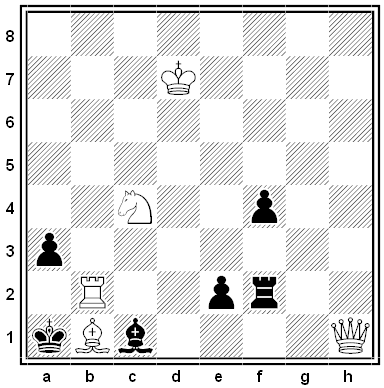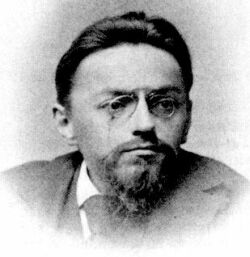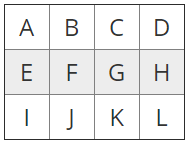
This problem, by G. Heathcote, won second prize in the Norwich Mercury‘s “King in the Corner” problem tournament, which required that Black’s king begin each problem in one of the board’s four corners. White to mate in two moves.

This problem, by G. Heathcote, won second prize in the Norwich Mercury‘s “King in the Corner” problem tournament, which required that Black’s king begin each problem in one of the board’s four corners. White to mate in two moves.

In 1883, Missouri real estate broker James Reavis announced that he held title to a huge tract of land in the Arizona Territory. If certified, the claim would threaten the livelihoods of thousands of residents. In this week’s episode of the Futility Closet podcast we’ll tell the story of the Baron of Arizona, one of the most audacious frauds in American history.
We’ll also scrutinize British statues and puzzle over some curious floor numbers.

In 1921 Charles Steinmetz, “the electrical wizard of Schenectady,” described the conveniences of 2021:
When heating is all done electrically, and I want 70 degrees in my home, I shall set the thermostat at 70 and the temperature will not rise above that point. This temperature will be maintained uniformly regardless of the weather outside.
This will also hold true on the warm day when the temperature outside may be 90 or 100 degrees. The same electrical apparatus will cool the air, and what’s more it will also keep the humidity normal at all times.
“Look back 100 years and it is like jumping into the Dark Ages,” he wrote. “The electrical development is still in its infancy.”
(Via Reddit’s ArchivePorn.)

This cottage, at 112 Mercer Street in Princeton, New Jersey, has been home to three Nobel winners: Albert Einstein lived there from 1935 to 1955; physicist Frank Wilczek between 1989 and 2001; and economist Eric Maskin until 2012.
It resides on the National Register of Historic Places and has been designated a U.S. National Historic Landmark, but it bears no outward marker of its significance.

In the 1940s, arborsculptor Axel Erlandson planted six sycamore trees in a circle and grafted them as they grew to form a “woven” unit with diamond interstices.
It’s now the centerpiece of California’s Gilroy Gardens.
A puzzle by Tim C., an applied research mathematician at the National Security Agency, from the agency’s January 2017 Puzzle Periodical:
Alice has a dozen cartons, arranged in a 3×4 grid, which for convenience we have labeled A through L:

She has randomly chosen two of the cartons and hidden an Easter egg inside each of them, leaving the remaining ten cartons empty. She gives the dozen cartons to Bob, who opens them in the order A, B, C, D, E, F, G, H, I, J, K, L until he finds one of the Easter eggs, whereupon he stops. The number of cartons that he opens is his score. Alice then reseals the cartons, keeping the eggs where they are, and presents the cartons to Chris, who opens the cartons in the order A, E, I, B, F, J, C, G, K, D, H, L, again stopping as soon as one of the Easter eggs is found, and scoring the number of opened cartons. Whoever scores lower wins the game; if they score the same then it’s a tie.
For example, suppose Alice hides the Easter eggs in cartons H and K. Then Bob will stop after reaching the egg in carton H and will score 8, while Chris will stop after reaching the egg in carton K and will score 9. So Bob wins in this case.
Who is more likely to win this game, Bob or Chris? Or are they equally likely to win?
In The Art of Computer Programming, Donald Knuth notes an interesting pattern in the common units of liquid measure in 13th-century England:
2 gills = 1 chopin
2 chopins = 1 pint
2 pints = 1 quart
2 quarts = 1 pottle
2 pottles = 1 gallon
2 gallons = 1 peck
2 pecks = 1 demibushel
2 demibushels = 1 bushel or firkin
2 firkins = 1 kilderkin
2 kilderkins = 1 barrel
2 barrels = 1 hogshead
2 hogsheads = 1 pipe
2 pipes = 1 tun
“Quantities of liquid expressed in gallons, pottles, quarts, pints, etc. were essentially written in binary notation,” Knuth writes. “Perhaps the true inventors of binary arithmetic were British wine merchants!”
(Thanks, Colin.)

In 1938, Douglas “Wrong Way” Corrigan departed New York, ostensibly headed for California, and flew instead to Ireland.
The New York Post ran this headline on Aug. 5.
“One can pay back the loan of gold, but one lies forever in debt to those who are kind.” — Marcus Aurelius
What most clinicians do when they receive a laboratory report is, of course, to look up the normal range for the tests in question. … Traditionally, a normal range is calculated in such a way that it includes 95% of the results found in a group of normal or healthy persons, and, consequently, there is a 5% risk that a healthy person will present with an abnormal laboratory result. Then, imagine that you do ten tests on a normal person. In that case the risk that at least one of these tests is abnormal is (1 – 0.9510) which amounts to 0.40 or 40%. If you do twenty-five tests (and that is not uusual in clinical practice), this chance is 72%! As Edmond A. Murphy puts it so aptly, ‘Therefore, a normal person is anyone who has not been sufficiently investigated.’
— Henrik R. Wulff, Stig Andur Pedersen, and Raben Rosenberg, Philosophy of Medicine: An Introduction, 1990, citing Murphy’s The Logic of Medicine, 1976